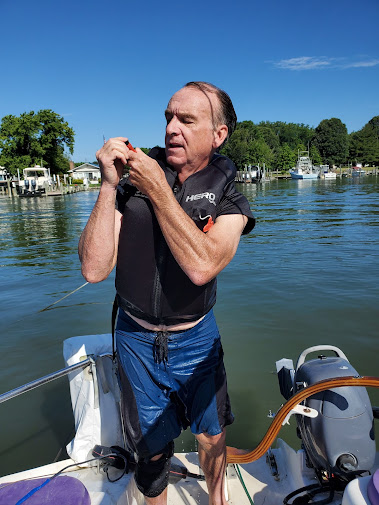Just a few of the projects:
Lathe-related
·
Shim or re-fit all lathe control handles. They
were sloppy.
·
Cross slide lock (homemade). Required for facing.
Or you can keep one hand on the main crank.
·
New cross slide hand wheel (homemade). The
original was too small and did not have a bearing.
·
Tailstock lapped to ways. Bad alignment.
·
Center finding gauge (homemade).
·
Compact depth gauge (homemade).
·
Bump center (homemade). It’s a thing made from
ball bearings to help align work in chuck.
·
Milling 90 degree plate (homemade) that bolts direct
to compound. Also hold-down bars and
studs.
·
Milling 90 degree plate that fits vertical slide
(below) (homemade). Additional hold-down
bars and studs. Toe clamps from 2-inch schd 40 pipe (homemade).
·
Marking/bolting 90 degree plate (homemade).
·
Vertical slide.
·
Vice for vertical slide.
·
Fitted milling vice. Handle needed re-machined.
Mounting holes.
·
Keyway mod in lathe tailstock. Stock keyway was
omitted at factory due to casting error.
·
Mods to drill press milling vice.
o
Handles and gibs.
o
Wider jaws with 6 screws and pressure plate (homemade).
·
Three machinist’s jacks (homemade), mostly for
use with the drill press and lathe.
·
Built shallow drawer under work bench for mics
etc.
·
Built drawer under lathe (right side, for lathe accessories),
with lift-out tray. More trays lower.
·
Built drawer under lathe (left side), for
milling accessories) with lift-out tray. More trays lower.
·
Several other drawers to organize drills and
boat fittings.
·
Organizer behind chip guard.
·
Ways cover (attached with aluminum strip embedded
with rare earth magnets).
·
Shallow, removable chip tray under chuck-half.
·
Face plates (2). Fitted from older lathe.
·
Hand turning rest (wood or metal) for metal
lathe (homemade).
·
Hand turning chisels for metal lathe (2) (homemade)
.
·
Chuck spider (homemade) (accessory to chuck
short stuff).
·
Parting tool holder using hacksaw blades (homemade).
Very good for brass, not steel. Got 1.5 mm parting tool from Buyaholic.
·
Manual die holders (1.5- and 2-inch) (homemade).
Not lathe mounted, but can start 1-, 1.5-, and 2-inch on lathe using chuck to
keep it straight. Removable handles.
·
Die pusher with aligning fit (homemade).
·
Tap follower. From great uncle.
·
Die grinder tool rest mount (homemade). Includes
short hose extension and air control valve.
·
Drip coolant at tool post. Mounts with magnet.
Probably over kill. (Also a bad idea—can’t see what you are doing, mess in
mechanism, corrosion. Better with a spray bottle or squeeze bottle.)
·
Indexing for lathe head (homemade) (24
increments). Great for making hex and square heads.
·
Precision filing guide (homemade). Can be used
for end stop or depth control.
·
Larger dog for turning between centers
(homemade). (I still have my old 1975 small home-made dog!)
·
Assorted custom handles for hex sockets and
square drives (homemade) (chuck and tool rest).
·
Radius turning attachment. 0.625” to 1.5” (homemade). For wide pulleys, such as trailer rollers, genoa leads, and low friction rings. A precision job, requiring milling, turning, threading, and indexed grinding. But not much bigger than my thumb.
Other projects (all homemade using lathe, welder, band saw,
drill press, etc.)
·
Bending lever, large stock. Up to ½-inch rebar.
·
Bending rod jig for vice, small stock. Bar stock
and up to about 3/8-inch round … maybe.
·
Band saw table and stand. Fence from speed
square. Sled from scrap.
·
Improved hold-down tee-nuts for drill press.
·
Tuned up cross slide vice for drill press. Now I
can mill on the press, up to ½-inch steel plate with ½-inch end mill.
·
Centers (top and bottom) for drill press table.
Good for accurate concentric drilling.
·
Wooden clamp to hold work from spinning.
·
Steel fence for drill press.
·
Drill press clamp (Keats Plate) for round stock
center drilling.
·
Drum sander table.
·
Tool handles. Lots, mostly for files.
·
9-inch disk sander stand. 90 degree fence.
·
Cradle for angle grinder (just for spin-down). I’m
going to upgrade this to 12-inch when I run out of 12-inch paper.
·
Scribe/awl from triangular file. Full length
tang. Very hard.
·
Light bracket for drill press. Old eyes appreciate
this.
·
Switched outlets to control air compressor and shop
air filter.
·
HEPA-rated show air filter from 5 MERV 13 20x20 filters
and a 20x20 box fan. Allows welding indoors. Every shop should have one. Also great for remodeling mess.
·
Soft jaws with magnets (both vices) . Aluminum
and wood.
·
Parallels with magnets. Parallel edge clamps for
non-magnetic parallels.
·
V-blocks. Many sizes. Wood, steel, and aluminum.
·
Table saw sled and mini-rip fence. More accurate
and less dust.
·
Zero clearance insert for table saw. Less dust.
·
Two hole deburing tools; one from a counter sink
and the other from a ½-drill with the clearance angle reduced (plus handles).
·
Edge deburing tool from a rusted triangular file
plus a handle. My favorite.
·
Up-side-down holders for 5-minute and G-Flex epoxy.
·
Cradle for angle grinder (for spin-down).
·
90 degree and variable angle brace/clamp for
welding
·
Mini-chipping hammer from rebar. My new
favorite.
And I'm sure there were more. And I'm reaping the benefits, as I now have just the tool or jig I need to do things more quickly and with better precision. More practice helps too.
The cost? Barely anything, since most were homemade. With welding, milling, and a lathe, you can make most things.




































%20that%20the%20opening..jpg)

